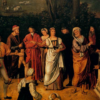Book Review—The Whole Church Sings: Congregational Singing in Luther’s Wittenberg, by Robin Leaver
Robin A. Leaver, The Whole Church Sings: Congregational Singing in Luther’s Wittenberg (Grand Rapids: Eerdmans, 2017). Pp. xiv + 206.
There are two things that make human beings different from all other creatures on the face of the earth. One is our ability to use language in constructive and reflective ways. A parrot might learn to make sounds that approximate to the occasional human word, a chimpanzee might be taught to order a diet soda by pushing specific plastic symbols across a table, but neither will ever write a sonnet or an autobiography.
The second difference is our facility with music. Only human beings have the brain physiology that allows us to hear harmony and melody. Perhaps it is not beyond the realm of plausibility, then, that these two things connect to that theological fact which makes us unique: only human beings are made in the image of God.
THE REFORMATION AND MUSIC
If we believe this to plausible, then is it not interesting that the Reformation placed both back at the center of the church’s corporate life? The Word read and especially preached became the primary means of grace. And while the medieval era had witnessed many interesting musical innovations, especially the development of plain chant and polyphony, singing in church was the prerogative of choirs, not the congregation.
Central to both stories—of preaching and singing—is Martin Luther. Therefore, Robert Leaver’s new study of congregational singing in 1520s Wittenberg—The Whole Church Sings: Congregational Singing in Luther’s Wittenberg—is a most helpful contribution to our understanding of the Reformation. Human beings aren’t simply shaped by ideas. Aesthetics plays an important role too, as does participation in corporate worship. To understand Protestantism—indeed, to understand Christianity—all of these aspects must be addressed.
Over eight chapters, Leaver traces the story of Wittenberg hymnody from its roots in the 15th century to the first major formal hymnbooks of the late 1520s. Five appendices give further details on specific editions of hymnals as well as hymns written by those other than Luther. Some of the discussion is technical and will appeal particularly to musicologists or those with a specific interest in the publishing history behind Luther hymnody. But there’s plenty to stimulate the minds of anyone with a desire to know more about worship in the Reformation and the rise of Protestant hymn-singing.
LUTHER
On the matter of worship and music two things have always struck me about Luther, both of which are borne out in Leaver’s book. First, Luther was acutely aware of the importance of aesthetics in worship. While he called for a vernacular liturgy in 1520, it wasn’t until 1525 that he implemented a full German Mass in Wittenberg.
Luther’s reasoning remains instructive. First, he wanted the music to match the words. German words needed to be accompanied by appropriate, German-sounding music. Second, he didn’t want to reform worship at such a rapid speed that the ordinary people who made up his congregation would be disturbed.
Both of these are evident in the ways early Wittenberg hymnody developed. While the medieval church may not have had congregational singing, there was nonetheless a string tradition of vernacular spiritual songs that shaped the piety of the day. In the early phases of The Reformation, Luther adopted many of these songs but modified their words to make them specifically Protestant. He also kept many familiar tunes. This was a move of typical pastoral sensitivity on his part: take the familiar and adapt it in such a way that the congregation was gently brought to where he desired them to be.
As stated in a 1523 letter, Luther planned to follow what he regarded as the Old Testament precedent: to compose vernacular psalms for the people to sing. The Psalms thus provided both significant content for hymnody and paradigms to be followed in future compositions. There is perhaps a little irony in the fact that the Reformed tradition’s emphasis on psalmody finds its initial inspiration in Wittenberg in the mid-1520s.
Luther’s hymnody highlighted the structural elements of his theology—law and gospel, sin, forgiveness in Christ. Luther and his colleagues knew the battle for hearts and minds needed to shape the whole liturgy of the church, not only in the overall catechetical structure of the week’s services but also in the individual services themselves. Singing was a vital part of this, both among the congregation and sometimes the choir. Both traditions find their origins in Luther’s work from late 1523 and early 1524.
FOR PASTORS TODAY
Why should present-day pastors and churches read this book and take Luther seriously? Simply this: in a day when biblical literacy among Christians is not impressive, and where the tendency is to have fewer worship services with less Bible reading, the importance of making every second of congregational worship count is paramount.
This means we need to pay attention both to the words sung and the music to which those words are set. This isn’t a plea for a return to Bach’s Lutheran masses, nor to the sentimentalism of so many contemporary songs and tunes. Rather, it’s a plea for us to learn from the great musical traditions of the past so that we can more intentionally impress the great truths of God upon congregations in a way that’s both edifying to us and glorifying to God.
So much of modern worship plays cheaply to the emotions. Of all the Reformers, Luther knew the ways in which Christianity struck deep emotional chords in the heart of the believer. But this meant he paid more attention, not less, to the words and the appropriateness of the music. Leaver’s book gives much food for thought in that context.








